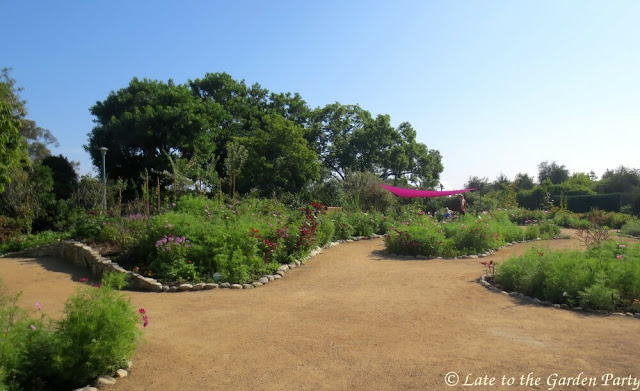South Coast Botanic Garden, roughly five miles from my home, opened its new "Pollination Garden" on July 1st and I popped in to check it out earlier this week. It occupies the space that housed the former children's garden, slated to be replaced by the 3.5 acre Children and Family Garden currently under construction in 2024. The new garden was created to link the space to the nearby butterfly pavilion.
Opening a new garden in July struck me as a brave thing to do in our climate but SCBG is approaching the project in two phases. Phase One involved sowing a wide range of seeds to create a meadow-like space to attract and support pollinators. I waited almost four weeks to visit the new garden to give the seedlings a chance to develop.
 |
| View of the new space from the opposite side of the tram road. I arrived just after SCBG opened at 8am, which on a hot summer's day was the right choice for my visit. |
 |
| View from the entrance off the tram road |
 |
| View looking roughly west in the direction of SCBG's entrance, with pre-existing mature trees in the background |
 |
| One of the large beds just inside the entrance to the space. The feathery foliage of the Cosmos plants was the first thing I noticed. They're just starting to bloom. |
The swaths of bright pink color were provided by shade sails.
 |
| Two of these provided places to take a break and rest in the shade |
There's a large pond in the middle of the area.
The garden beds are full, although the flower power contained in them is still light. I expect the bloom count will be much higher in August and September.
I collected closeup photos of some of the plants I saw. A few appeared to be holdovers from peripheries of the former garden.
 |
| My phone identified the mature tree on the left as Asimina triloba (aka American pawpaw). The trees on the right are new and, off the cuff, I couldn't identify them. |
Signs are scattered throughout the area.
 |
| I was impressed by the plant identifications on each of the signs, which included the plant's species name as well as the common name |
Phase Two of the project is scheduled to kick off in November when the annuals currently in place will be replaced by native and adapted plants suitable to our Mediterranean climate. The native plants will reportedly be sourced by the Palos Verdes Peninsula Land Conservancy with support from the Theodore Payne Foundation. SCBG's Director of Living Collections, Terry Huang, is channeling the approach used by Olivier and Clara Filippi in France. They specialize in "drought resilient" plants. I was introduced to Olivier Filippi many years ago via a video a fellow blogger who lived in Italy linked me too. I think it was probably the recording of a talk he did in Athens in 2013 (which can be found here). It made a big impression on me at the time. If you're interested, he has at least one other video from a presentation at a Beth Chatto Symposium in 2019, which you can find here. I have Filippi's first book (English translation), which I'm going to take another look at. He has two other books expanding on what he and his wife have learned about planting and maintaining a climate-appropriate garden under ever more challenging circumstances.
 |
| The book was originally published in French in 2008 |
I'm looking forward to seeing what the Phase One garden looks like in another four to six weeks, and I'm even more interested in seeing how the Phase Two garden develops.
Best wishes for a pleasant weekend.
All material © 2012-2023 by Kris Peterson for Late to the Garden Party



